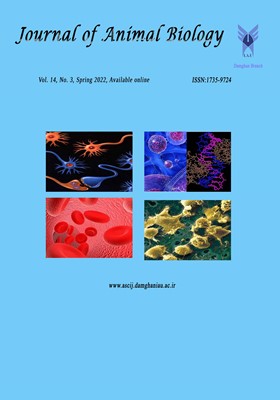Gene Expression of MyF5 and MyoG Genes of Eccentric and Concentric Resistance Activity in the Vastus Lateralis Muscle of Healthy Individuals
Subject Areas :
Journal of Animal Biology
Farzaneh Akhgar
1
,
Lida Moradi
2
,
Yaser Kazemzadeh
3
1 - Department of Physical Education and Sport Science, North Tehran Branch, Islamic Azad University, Tehran, Iran
2 - Department of Physical Education and Sport Science, North Tehran Branch, Islamic Azad University, Tehran, Iran
3 - Department of Sport Physiology, Islamshahr Branch, Islamic Azad University, Islamshahr, Iran
Received: 2021-08-27
Accepted : 2022-09-26
Published : 2022-05-22
Keywords:
concentric contraction,
eccentric contraction,
MyF5,
MyoG,
Abstract :
This study was mainly aimed at investigating gene expression of MyF5 and MyoG genes of eccentric and concentric resistance activity in the vastus lateralis muscle of healthy individuals. Ten healthy men were randomly assigned to two groups of concentric and eccentric contractions of five. Isokinetic contraction protocols included eccentric and concentric knee extension with a maximum power and angular velocity of 60 degrees per second. The torque set for each subject was considered the same in both protocols in order to match the load, and the reciprocating speed was 60 degrees per second. At the beginning and end of the activity, extensive biopsy was performed to examine the expression of MyF5 and MyoG genes. Results revealed that intra-group changes of MyF5 after one session of exercise were significant in eccentric (p = 0.001) and non-significant in concentric (p = 0.069) group. Moreover, inter-group changes showed no difference between the two group (p = 0.371). Besides, intra-group MyoG changes after one session of exercise were significant in the eccentric group (p = 0.001) and concentric group (p = 0.001). Furthermore, inter-group changes showed no difference between the two groups (p = 0.681). Overall, the present study showed that a session of eccentric and concentric activity leads to changes in the factors involved in skeletal muscle strength and hypertrophy. In addition, these changes in aggregate eccentric contraction are more than concentric..
References:
Bazgir, B., Fathi, R., Valojerdi, M.R., Mozdziak, P., and Asgari, A. 2017. Satellite cells contribution to exercise mediated muscle hypertrophy and repair. Cell Journal (Yakhteh), 18(4):
Bickel, C. S., Slade, J., Mahoney, E., Haddad, F., Dudley, G. A., and Adams, G. R. (2005). Time course of molecular responses of human skeletal muscle to acute bouts of resistance exercise. Journal of Applied Physiology, 98(2): 482-488.
Biglari, S., Gaeini, A. A., Kordi, M. R., and Ghardashi Afousi, A. 2018. The Effect of 8 Weeks High-intensity Interval Training on Myostatin and Follistatin Gene Expression in Gastrocnemius Muscle of the Rats. Journal of Arak University of Medical Sciences, 21(1): 1-10.
Dieli-Conwright, C. M., Kiwata, J. L., Tuzon, C. T., Spektor, T. M., Sattler, F. R., Rice, J. C., and Schroeder, E. T. 2016. Acute Response of PGC-1alpha and IGF-1 Isoforms to Maximal Eccentric Exercise in Skeletal Muscle of Postmenopausal Women. The Journal of Strength and Conditioning Research, 30(4): 1161-1170.
Fang, Y., Siemionow, V., Sahgal, V., Xiong, F., Yue, G. H. 2001. Greater movement-related cortical potential during human eccentric versus concentric muscle contractions. Journal of Neurophysiology, 86(4): 1764-1772.
Hortobagyi, T., Barrier, J., Beard, D., Braspennincx, J., Koens, P., Devita, P., Lambert, J. 1996. Greater initial adaptations to submaximal muscle lengthening than maximal shortening. Journal of Applied Physiology, 81(4): 1677-1682.
Hughes, S. M., Chi, M. M.-Y., Lowry, O. H., and Gundersen, K. 1999. Myogenin induces a shift of enzyme activity from glycolytic to oxidative metabolism in muscles of transgenic mice. The Journal of Cell Biology, 145(3): 633-642.
Kay, D., St Clair Gibson, A., Mitchell, M. J., Lambert, M. I., and Noakes, T. D. 2000. Different neuromuscular recruitment patterns during eccentric, concentric and isometric contractions. Journal of Electromyography and Kinesiology, 10(6): 425-431.
Kosek, D. J., Kim, J.-s., Petrella, J. K., Cross, J.M., Bamman, M.M. 2006. Efficacy of 3 days/wk resistance training on myofiber hypertrophy and myogenic mechanisms in young vs. older adults. Journal of Applied Physiology, (1985). 101(2): 531-544.
Lee, J.H., Jun, H.S. 2019. Role of myokines in regulating skeletal muscle mass and function. Front Physiology, 10(42): 27-35.
Mallinson, J.E., Taylor, T., Constantin‐Teodosiu, D., Billeter‐Clark, R., Constantin, D., Franchi, M. V., Greenhaff, P. L. 2020. Longitudinal hypertrophic and transcriptional responses to high‐load eccentric‐concentric vs concentric training in males. Scandinavian Journal of Medicine and Science in Sports, 30(11): 2101-2115.
McCarthy, J. J., Mula, J., Miyazaki, M., Erfani, R., Garrison, K., Farooqui, A. B., Keller, C. 2011. Effective fiber hypertrophy in satellite cell-depleted skeletal muscle. Development, 138(17): 3657-3666.
Meckel, Y., Eliakim, A., Seraev, M., Zaldivar, F., Cooper, D. M., Sagiv, M., and Nemet, D. 2009. The effect of a brief sprint interval exercise on growth factors and inflammatory mediators. The Journal of Strength and Conditioning Research, 23(1): 225-230.
Nederveen, J., Joanisse, S., Séguin, C., Bell, K., Baker, S., Phillips, S., Parise, G. 2015. The effect of exercise mode on the acute response of satellite cells in old men. Acta Physiologica, 215(4): 177-190.
Petrella, J. K., Kim, J.-s., Mayhew, D. L., Cross, J. M., and Bamman, M. M. (2008). Potent myofiber hypertrophy during resistance training in humans is associated with satellite cell-mediated myonuclear addition: a cluster analysis. Journal of Applied Physiology, 145(3), 633-642.
Psilander, N., Damsgaard, R., and Pilegaard, H. 2003. Resistance exercise alters MRF and IGF-I mRNA content in human skeletal muscle. Journal of Applied Physiology, 95(3): 1038-1044.
Raue, U., Trappe, T. A., Estrem, S. T., Qian, H.-R., Helvering, L. M., Smith, R. C., and Trappe, S. 2012. Transcriptome signature of resistance exercise adaptations: mixed muscle and fiber type specific profiles in young and old adults. Journal of Applied Physiology, 112(10): 1625-1636.
Taghibeikzadehbadr, P., Shirian, S., and Sabouri, M. 2020. Effect of different muscle contraction mode on the expression of Myostatin, IGF-1, and PGC-1 alpha family members in human vastus lateralis muscle. Molecular Biology Reports, 47(12): 9251-9258.
Yang, Y., Creer, A., Jemiolo, B., and Trappe, S. 2005. Time course of myogenic and metabolic gene expression in response to acute exercise in human skeletal muscle. Journal of Applied Physiology, 98(5): 1745-1752.
_||_


